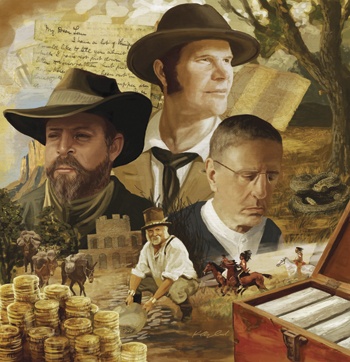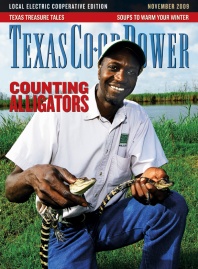If you believe the tales, the Lone Star State is a land of lost mines, buried treasure and hidden outlaw loot. There’s untold—and unfound—wealth in almost all of its 254 counties.
Although these tales may inspire treasure seekers of all ages to try to strike it rich, pull back on the reins a bit: The vast majority of lands in the state are privately owned, and access to them requires a property owner’s permission. In state and national parks, the collecting of artifacts, minerals and natural objects is strictly prohibited. With that in mind, grab an imaginary pick and shovel, metal detector and dowsing rod and mine the fabulous fortunes of your own fantasies.
The Lost San Saba Mine
The Lost San Saba Mine, believed to be located somewhere within the Menard-San Saba-Llano triangle of the Hill Country, has been the Holy Grail of Texas treasure tales for more than 250 years.
In 1756, a dispatch reached Madrid from the region of New Spain known as Texas. The report was from Bernardo de Miranda y Flores, an agent of the crown who had been prospecting for mineral wealth in what is now called the Hill Country, 5,000 miles from Spain. Detailing the discovery of a massive, rich vein of silver ore, the document reportedly read, in part: “The mines which are in the Cerro del Almagre (a hill of red ocher) are so numerous that I guarantee to give to every settler of the province of Texas a full claim.”
The Spanish established a mission on the western San Saba River near what is now Menard, and a presidio was established a few miles away. The mining reportedly was very profitable until 1758, when several allied Indian tribes attacked and destroyed the mission, wiping out all but a few who escaped to the presidio. The mission was never re-established, and the presidio was abandoned a decade or so later.
The lure of the silver continued, though, and many searched for the mine, or mines, or hidden caches of silver ingots believed left behind by the Spaniards. The most famous seeker of the treasure was Jim Bowie, who would later find glory in a crumbling mission called the Alamo. He, his brother Rezin and nine other men left San Antonio in 1831 to retrieve the silver. According to some stories, Jim Bowie wanted to use the windfall to help fund the Texas Revolution.
While meandering toward their goal, the adventurers were attacked by more than 100 Indians at Calf Creek in McCulloch County in a skirmish reported to be about 30 miles east of the old mission and presidio. The greatly outnumbered troops took cover, and in the ensuing battle the Texans lost one man, while 50 or so Indians were killed. The Bowie party made its way back to San Antonio, but subsequent historical events prevented a return attempt to seek the fortune.
Short-story writer William Sydney Porter, better known as O. Henry, worked in the Texas General Land Office in Austin in the late 1800s. Information he gleaned there led him to search for the Lost San Saba Mine and to write the short story “Buried Treasure.”
Fact or Fiction? Early maps of Texas in the 1820s and ’30s, including at least one compiled by Stephen F. Austin, are clearly marked in the general area of the San Saba-Llano-Colorado river areas with the words “Silver Mines” on them. But The Handbook of Texas, an authoritative source on Texas history, calls the story of the Lost San Saba Mine a legend.
The Rock Pens
On his deathbed in Austin in 1873, Daniel Dunham revealed an incredible tale of buried treasure in the South Texas brush country. He and a band of outlaws had looted a silver mine and a church in Mexico and were returning to Texas across the Rio Grande when Indians and/or Mexican pursuers set upon them.
The outlaws hastily made low-walled rock pens, buried the loot in one enclosure and repeatedly ran their mules over the site to cover the signs of digging. In the ensuing battle, only one of the bandits, Dunham, escaped alive. He claimed that buried inside the treasure pen were 31 mule loads of silver bullion and other valuables. His rough directions—six or seven miles below the Laredo Crossing south of the Nueces River—are so vague, relative to the vast ranch land of that part of Texas, that the pens have never been pinpointed. Most treasure seekers believe that they are in La Salle, Live Oak or McMullen counties.
Fact or Fiction? Folklorist J. Frank Dobie was a big believer in this treasure, having passed along the tale in several of his writings. He also implied that during his research, he saw the deathbed letter written by Dunham that vaguely alluded to the location of the loot.
The Lost Gold of the Guadalupes
In the mid-1800s, Ben Sublett was considered a crazy prospector in the far reaches of West Texas. A widower, he would often disappear into the badlands along the Texas-New Mexico border for weeks on end, leaving his children to fend for themselves in Odessa. But when he reportedly started returning to town with pouches of gleaming yellow nuggets, the locals took notice.
When the latest pouch of gold ran out, most of it spent in frontier saloons, he would head back west, and many tried to follow him to the source—all unsuccessfully. Sublett once took his young son to the mine, somewhere in or near the Guadalupe Mountains—at that time one of the last great Apache strongholds—but after his father’s death in 1892, the son could never return to the exact location.
Many believe the mine is somewhere near McKittrick Canyon in what is now Guadalupe Mountains National Park, but others put its location in the Rustler Hills at the base of the range.
Fact or Fiction? According to The Handbook of Texas, “Rumors of fabulously wealthy gold mines in the Guadalupes seem to be mere wishful thinking.”
Steinheimer’s Millions
Karl Steinheimer, a German-born adventurer, was a well-known and feared smuggler and privateer based in Galveston before 1820. In the late 1820s, he moved south to pursue riches in Mexico mines.
His destiny changed in 1838, in the early days of the Republic of Texas. Deciding to rekindle an old romance in St. Louis, he cashed in his mining interests, which were said to amount to 10 mule loads of gold and silver, and for protection he hired several men to accompany the caravan to St. Louis.
Tensions between Mexicans and Texans were still high after the Texas Revolution ended in 1836, and Steinheimer and his group came upon trouble after joining up with a Mexican military contingent on the San Antonio road. When it became clear that there was a skirmish looming between the Mexicans and Texans in the area, Steinheimer’s caravan separated from the military contingent and turned off the road, heading across the wilds of the Hill Country.
Realizing their dire circumstances, Steinheimer decided to bury his cargo, driving a brass spike into a nearby oak tree as a marker. A few miles farther on, Indians attacked the small band. All of his escorts were killed, but Steinheimer, badly injured and on foot, somehow managed to draw a rough map to the treasure and write a letter to his sweetheart, telling her that if he didn’t appear within a certain time, she should assume that he was dead and should retrieve the treasure. According to legend, he was not heard from again.
Awaiting a more settled Texas, his sweetheart eventually sent a contingent to seek the fortune, but the brass spike could not be found and the treasure remains undiscovered. According to some accounts, it is in Bell County near where the Lampasas and Leon rivers meet to form the Little River.
Fact or Fiction? The tradition of Steinheimer’s treasure is deeply rooted in Central Texas, and scores of articles and stories about it have been printed and passed down since the early 20th century and even before. The treasure is not mentioned in The Handbook of Texas.
All or any of these treasure tales may or may not be true. Remember Shakespeare’s famous admonition: All that glitters is not gold.
——————–
Paul Cline Jr., a native Texan, started his journalism career in 1980. A freelance writer/editor living in Fort Worth, he is always hoping to strike it rich.


